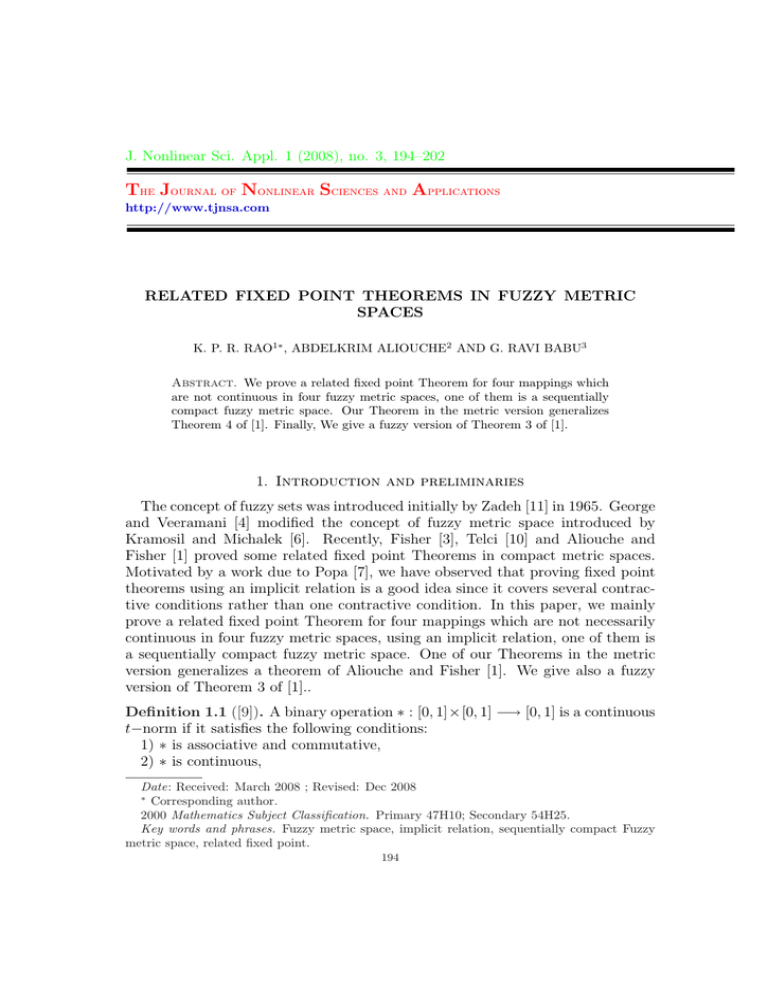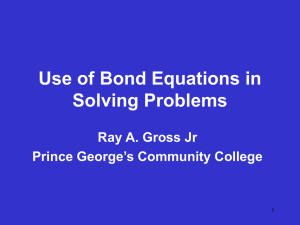T J N S
advertisement

J. Nonlinear Sci. Appl. 1 (2008), no. 3, 194–202
The Journal of Nonlinear Sciences and Applications
http://www.tjnsa.com
RELATED FIXED POINT THEOREMS IN FUZZY METRIC
SPACES
K. P. R. RAO1∗ , ABDELKRIM ALIOUCHE2 AND G. RAVI BABU3
Abstract. We prove a related fixed point Theorem for four mappings which
are not continuous in four fuzzy metric spaces, one of them is a sequentially
compact fuzzy metric space. Our Theorem in the metric version generalizes
Theorem 4 of [1]. Finally, We give a fuzzy version of Theorem 3 of [1].
1. Introduction and preliminaries
The concept of fuzzy sets was introduced initially by Zadeh [11] in 1965. George
and Veeramani [4] modified the concept of fuzzy metric space introduced by
Kramosil and Michalek [6]. Recently, Fisher [3], Telci [10] and Aliouche and
Fisher [1] proved some related fixed point Theorems in compact metric spaces.
Motivated by a work due to Popa [7], we have observed that proving fixed point
theorems using an implicit relation is a good idea since it covers several contractive conditions rather than one contractive condition. In this paper, we mainly
prove a related fixed point Theorem for four mappings which are not necessarily
continuous in four fuzzy metric spaces, using an implicit relation, one of them is
a sequentially compact fuzzy metric space. One of our Theorems in the metric
version generalizes a theorem of Aliouche and Fisher [1]. We give also a fuzzy
version of Theorem 3 of [1]..
Definition 1.1 ([9]). A binary operation ∗ : [0, 1]×[0, 1] −→ [0, 1] is a continuous
t−norm if it satisfies the following conditions:
1) ∗ is associative and commutative,
2) ∗ is continuous,
Date: Received: March 2008 ; Revised: Dec 2008
Corresponding author.
2000 Mathematics Subject Classification. Primary 47H10; Secondary 54H25.
Key words and phrases. Fuzzy metric space, implicit relation, sequentially compact Fuzzy
metric space, related fixed point.
∗
194
RELATED FIXED POINT THEOREMS IN FUZZY METRIC SPACES
195
3) a ∗ 1 = a for all a ∈ [0, 1],
4) a ∗ b ≤ c ∗ d whenever a ≤ c and b ≤ d, for each a, b, c, d ∈ [0, 1].
Two typical examples of a continuous t−norm are a ∗ b = ab and a ∗ b =
min{a, b}.
Definition 1.2 ([4]). A 3-tuple (X, M, ∗) is called a fuzzy metric space if X is
an arbitrary (non-empty) set, ∗ is a continuous t−norm a and M is a fuzzy set on
X 2 × (0, ∞) satisfying the following conditions for each x, y, z ∈ X and t, s > 0,
1) M (x, y, t) > 0,
2) M (x, y, t) = 1 if and only if x = y,
3) M (x, y, t) = M (y, x, t),
4) M (x, y, t) ∗ M (y, z, s) ≤ M (x, z, t + s),
5) M (x, y, .) : (0, ∞) −→ [0, 1] is continuous.
Definition 1.3 ([3]). Let (X, M, ∗) be a fuzzy metric space.
1) For t > 0, the open ball B(x, r, t) with center x ∈ X and radius 0 < r < 1
is defined by
B(x, r, t) = {y ∈ X : M (x, y, t) > 1 − r}.
2) Let (X, M, ∗) be a fuzzy metric space and τ be the set of all A ⊂ X with
x ∈ A if and only if there exist t > 0 and 0 < r < 1 such that B(x, r, t) ⊂ A.
Then, τ is a topology on X induced by the fuzzy metric M .
3) A sequence {xn } in X converges to x if and only if for any 0 < ² < 1 and
t > 0, there exists n0 ∈ N such that for all n ≥ n0 , M (xn , x, t) > 1 − ² ; i.e.,
M (xn , xm , t) → 1 as n → ∞ for all t > 0.
4) A sequence {xn } in X is called a Cauchy sequence if and only if for any 0 <
² < 1 and t > 0, there exists n0 ∈ N such that for all n, m ≥ n0 , M (xn , xm , t) >
1 − ² ; i.e., M (xn , xm , t) → 1 as n, m → ∞ for all t > 0.
5) A fuzzy metric space (X, M, t) in which every Cauchy sequence is convergent
is said to be complete.
Definition 1.4. A subset A of X is said to be F −bounded if there exists t > 0
and 0 < r < 1 such that M (x, y, t) > 1 − r for all x, y ∈ A.
Lemma 1.5 ([5]). Let (X, M, ∗) be a fuzzy metric space. Then, M (x, y, t) is
non-decreasing with respect to t, for all x, y in X.
Lemma 1.6 ([5]). Let (X, M, ∗) be a fuzzy metric space. Then, M is a continuous
function on X 2 × (0, ∞).
Definition 1.7. (X, M, ∗) is said to be sequentially compact fuzzy metric space
if every sequence in X has a convergent sub-sequence in it.
Let Φ be the set of all functions φ : [0, 1]6 −→ [0, 1] such that if either
φ(u, 1, u, v, v, 1) > 0 or φ(u, u, 1, v, 1, v) > 0 for all u, v ∈ [0, 1), then u > v.
Example 1.8. Let φ(t1 , t2 , t3 , t4 , t5 , t6 ) = t1 − min{t2 , t3 , t4 , t5 , t6 }. Then φ ∈ Φ.
196
K. P. R. RAO, A. ALIOUCHE AND G. R. BABU.
2. Main results
Theorem 2.1. Let (X, M1 , θ1 ), (Y, M2 , θ2 ), (Z, M3 , θ3 ) and (W, M4 , θ4 ) be fuzzy
metric spaces and B : X −→ Y , T : Y −→ Z , A : Z −→ W , S : W −→ X be
mappings satisfying
M1 (SAT y, SAT Bx, t), M1 (x, SAT y, t),
>0
M1 (x, SAT Bx, t), M2 (y, Bx, t),
(1) φ1
M2 (y, BSAT y, t), M2 (Bx, BSAT y, t)
for all x ∈ X, y ∈ Y with y 6= Bx and for all t > 0, where φ1 ∈ Φ,
M2 (BSAz, BSAT y, t), M2 (y, BSAz, t),
>0
M2 (y, BSAT y, t), M3 (z, T y, t),
(2) φ2
M3 (z, T BSAz, t), M3 (T y, T BSAz, t)
for all z ∈ Z, y ∈ Y with z 6= T y and for all t > 0, where φ2 ∈ Φ,
M3 (T BSw, T BSAz, t), M3 (z, T BSw, t),
>0
M3 (z, T BSAz, t), M4 (w, Az, t),
(3) φ3
M4 (w, AT BSw, t), M4 (Az, AT BSw, t)
for all z ∈ Z, w ∈ W with w 6= Az and for all t > 0, where φ3 ∈ Φ,
M4 (AT Bx, AT BSw, t), M4 (w, AT Bx, t),
>0
M4 (w, AT BSw, t), M1 (x, Sw, t),
(4) φ4
M1 (x, SAT Bx, t), M1 (Sw, SAT Bx, t)
for all x ∈ X, w ∈ W with x 6= Sw and for all t > 0, where φ4 ∈ Φ.
Further, suppose that one of the following is true:
(a) (X, M1 , θ1 ) is sequentially compact and SAT B is continuous on X.
(b) (Y, M2 , θ2 ) is sequentially compact and BSAT is continuous on Y .
(c) (Z, M3 , θ3 ) is sequentially compact and T BSA is continuous on Z.
(d) (W, M4 , θ4 ) is sequentially compact and AT BS is continuous on W .
Then, SAT B has a unique fixed point u ∈ X, BSAT has a unique fixed point
v ∈ Y , T BSA has a unique fixed point w ∈ Z and AT BS has a unique fixed
point q ∈ W . Further, Bu = v , T v = w , Aw = q and Sq = u.
Proof. Suppose that (a) holds. For every t > 0, define φ(x) = M1 (x, SAT Bx, t)
for all x ∈ X. Then, there exists p ∈ X such that φ(p) = M1 (p, SAT Bp, t) =
max{φ(x) : x ∈ X}.
Suppose that BSAT BSAT Bp 6= BSAT BSAT BSAT Bp. Then, T BSAT Bp 6=
T BSAT BSAT Bp, AT Bp 6= AT BSAT Bp and p 6= SAT Bp.
Putting y = BSAT BSAT Bp and x = SAT BSAT BSAT Bp in (1) we have
M1 (SAT BSAT BSAT Bp, SAT BSAT BSAT BSAT Bp, t),
M1 (SAT BSAT BSAT Bp, SAT BSAT BSAT Bp, t),
M
(SAT
BSAT
BSAT
Bp,
SAT
BSAT
BSAT
BSAT
Bp,
t),
φ1 1
>0
M2 (BSAT BSAT Bp, BSAT BSAT BSAT Bp, t),
M2 (BSAT BSAT Bp, BSAT BSAT BSAT Bp, t),
M2 (BSAT BSAT BSAT Bp, BSAT BSAT BSAT Bp, t)
RELATED FIXED POINT THEOREMS IN FUZZY METRIC SPACES
197
and so
(5) φ(SAT BSAT BSAT Bp) > M2 (BSAT BSAT Bp, BSAT BSAT BSAT Bp, t).
Putting y = BSAT BSAT Bp and z = T BSAT Bp in (2) we get
M2 (BSAT BSAT Bp, BSAT BSAT BSAT Bp, t),
M2 (BSAT BSAT Bp, BSAT BSAT Bp, t),
M
(BSAT
BSAT
Bp,
BSAT
BSAT
BSAT
Bp,
t),
φ2 2
> 0.
M3 (T BSAT Bp, T BSAT BSAT Bp, t),
M3 (T BSAT Bp, T BSAT BSAT Bp, t),
M3 (T BSAT BSAT Bp, T BSAT BSAT Bp, t)
Therefore
(6)
M2 (BSAT BSAT Bp, BSAT BSAT BSAT Bp, t)
> M3 (T BSAT Bp, T BSAT BSAT Bp, t).
Putting z = T BSAT Bp and w = AT Bp in (3) we obtain
M3 (T BSAT Bp, T BSAT BSAT Bp, t),
M3 (T BSAT Bp, T BSAT Bp, t),
M
(T
BSAT Bp, T BSAT BSAT Bp, t),
φ3 3
M4 (AT Bp, AT BSAT Bp, t),
M4 (AT Bp, AT BSAT Bp, t),
M4 (AT BSAT Bp, AT BSAT Bp, t)
>0
and so
(7) M3 (T BSAT Bp, T BSAT BSAT Bp, t) > M4 (AT Bp, AT BSAT Bp, t).
Putting w = AT Bp and x = p in (4) we have
M4 (AT Bp, AT BSAT Bp, t), M4 (AT Bp, AT Bp, t),
φ4 M4 (AT BP, AT BSAT Bp, t), M1 (p, SAT Bp, t), > 0.
M1 (p, SAT Bp, t), M1 (SAT Bp, SAT Bp, t)
Hence
(8) M4 (AT Bp, AT BSAT Bp, t) > M1 (p, SAT Bp, t) = φ(p).
From (5), (6), (7) and (8) we get φ(SAT BSAT BSAT Bp) > φ(p) which is a
contradiction. Therefore
(9) BSAT BSAT Bp = BSAT BSAT BSAT Bp.
Denote BSAT BSAT Bp = v ∈ Y . Then from (9), v = BSAT v.
Let T v = w ∈ Z, Aw = q ∈ W , Sq = u ∈ X. Then v = BSAT v = BSAw =
BSq = Bu.
Also, SAT Bu = SAT v = SAw = Sq = u, T BSAw = T BSq = T Bu = T v = w
and AT BSq = AT Bu = AT v = Aw = q.
For the uniqueness of u, suppose that SAT Bu0 = u0 with u 6= u0 . Then,
SAT Bu 6= SAT Bu0 , AT Bu 6= AT Bu0 , T Bu 6= T Bu0 and Bu 6= Bu0 .
198
K. P. R. RAO, A. ALIOUCHE AND G. R. BABU.
Putting x = u and y = Bu0 in (1) we have
M1 (SAT Bu0 , SAT Bu, t), M1 (u, SAT Bu0 , t),
>0
M1 (u, SAT Bu, t), M2 (Bu0 , Bu, t),
φ1
0
0
0
M2 (Bu , BSAT Bu , t), M2 (Bu, BSAT Bu , t)
and so
M1 (u, u0 , t) > M2 (Bu, Bu0 , t)....(10).
Putting z = T Bu, y = Bu0 in (2) we get
M2 (BSAT Bu, BSAT Bu0 , t), M2 (Bu0 , BSAT Bu, t),
> 0.
M2 (Bu0 , BSAT Bu0 , t), M3 (T Bu, T Bu0 , t),
φ2
0
M3 (T Bu, T BSAT Bu, t), M3 (T Bu , T BSAT Bu, t)
Therefore
M2 (Bu, Bu0 , t) > M3 (T Bu, T Bu0 , t).....(11).
Putting z = T Bu, w = AT Bu0 in (3) we obtain
M3 (T BSAT Bu0 , T BSAT Bu, t), M3 (T Bu, T BSAT Bu0 , t),
> 0.
M3 (T Bu, T BSAT Bu, t), M4 (AT Bu0 , AT Bu, t),
φ3
0
0
0
M4 (AT Bu , AT BSAT Bu , t), M4 (AT Bu, AT BSAT Bu , t)
Hence
M3 (T Bu, T Bu0 , t) > M4 (AT Bu, AT Bu0 , t)....(12)
Putting x = SAT Bu, w = AT Bu0 in (4) we have
M4 (AT BSAT Bu, AT BSAT Bu0 , t), M4 (AT Bu0 , AT BSAT Bu, t),
>0
M4 (AT Bu0 , AT BSAT Bu0 , t), M1 (SAT Bu, SAT Bu0 , t),
φ4
0
M1 (SAT Bu, SAT BSAT Bu, t), M1 (SAT Bu , SAT BSAT Bu, t))
and so
M4 (AT Bu, AT Bu0 , t) > M1 (u, u0 , t)....(13)
Using (10), (11), (12) and (13) we get
M1 (u, u0 , t) > M1 (u, u0 , t)
which is a contradiction. Hence, u is the unique fixed point of SAT B. Similarly,
we can prove the uniqueness of fixed points of BSAT , T BSA and AT BS. In a
similar manner, the Theorem holds if either (b) or (c) or (d) is true.
¤
The following Example illustrates Theorem 2.1.
Example 2.2. Let X = [0, 1], Y = [1, 2) , Z = (2, 3] and W = [3, 4) and
t
t
t
, M2 (y, z, t) =
, M3 (z, w, t) =
and
M1 (x, y, t) =
t + |x − y|
t + |y − z|
t + |z − w|
t
M4 (w, x, t) =
.
t + |w − x|
Define B : X −→ Y by:
½
1 if x ∈ [0, 3/4],
Bx =
3/2 if x ∈ (3/4, 1].
RELATED FIXED POINT THEOREMS IN FUZZY METRIC SPACES
199
T : Y −→ Z by T y = 3 for all y ∈ Y , A : Z −→ W by
½
7/2 if x ∈ (2, 5/2],
Az =
3 if x ∈ (5/2, 3].
and S : W −→ X by Sw = 1 for all w ∈ W . Let
φ1 (t1 , t2 , t3 , t4 , t5 , t6 ) = t1 − min{t2 , t3 , t4 , t5 , t6 } and
φ1 = φ2 = φ3 = φ4 .
In this Example, the inequalities (1), (2), (3) and (4) are satisfied since the value
of the left hand side of each inequality is 1.
Clearly, SAT B(1) = 1, BSAT (3/2) = 3/2, T BSA(3) = 3, AT BS(3) = 3 and
B1 = 3/2, T (3/2) = 3, A3 = 3, S3 = 1.
If B = T , T = S, A = R, S = I (Identity map) and W = X in Theorem 2.1
we get the following Theorem.
Theorem 2.3. Let (X, M1 , θ1 ), (Y, M2 , θ2 ) and (Z, M3 , θ3 ) be fuzzy metric spaces
and T : X −→ Y , S : Y −→ Z , R : Z −→ X be mappings satisfying
¶
µ
M1 (RSy, RST x, t), M1 (x, RSy, t), M1 (x, RST x, t),
>0
(1) φ1
M2 (y, T x, t), M2 (y, T RSy, t), M2 (T x, T RSy, t)
for all x ∈ X, y ∈ Y with y 6= T x and for all t > 0, where φ1 ∈ Φ,
µ
¶
M2 (T Rz, T RSy, t), M2 (y, T Rz, t), M2 (y, T RSy, t),
(2) φ2
>0
M3 (z, Sy, t), M3 (z, ST Rz, t), M3 (Sy, ST Rz, t)
for all z ∈ Z, y ∈ Y with z 6= Sy and for all t > 0, where φ2 ∈ Φ,
¶
µ
M3 (ST x, ST Rz, t), M3 (z, ST x, t), M3 (z, ST Rz, t),
(3) φ3
>0
M1 (x, Rz, t), M1 (x, RST x, t), M1 (Rz, RST x, t)
for all z ∈ Z, x ∈ X with x 6= Rz and for all t > 0, where φ3 ∈ Φ.
Further, suppose that one of the following is true:
(a) (X, M1 , θ1 ) is sequentially compact and RST is continuous on X.
(b) (Y, M2 , θ2 ) is sequentially compact and T RS is continuous on Y .
(c) (Z, M3 , θ3 ) is sequentially compact and ST R is continuous on Z.
Then, RST has a unique fixed point u ∈ X, T RS has a unique fixed point v ∈ Y
and ST R has a unique fixed point w ∈ Z. Further, T u = v, Sv = w and Rw = u.
If R = I (Identity map) and Z = X in Theorem 2.3 we obtain
Theorem 2.4. Let (X, M1 , θ1 ) and (Y, M2 , θ2 ) be fuzzy metric spaces and T :
X −→ Y , S : Y −→ X be mappings satisfying
µ
¶
M1 (Sy, ST x, t), M1 (x, Sy, t), M1 (x, ST x, t),
(1) φ1
>0
M2 (y, T x, t), M2 (y, T Sy, t), M2 (T x, T Sy, t)
for all x ∈ X, y ∈ Y with y 6= T x and for all t > 0, where φ1 ∈ Φ,
µ
¶
M2 (T x, T Sy, t), M2 (y, T x, t), M2 (y, T Sy, t),
(2) φ2
>0
M1 (x, Sy, t), M1 (x, ST x, t), M1 (Sy, ST x, t)
for all x ∈ X, y ∈ Y with x 6= Sy and for all t > 0, where φ2 ∈ Φ.
Further, suppose that one of the following is true:
200
K. P. R. RAO, A. ALIOUCHE AND G. R. BABU.
(a) (X, M1 , θ1 ) is sequentially compact and ST is continuous on X.
(b) (Y, M2 , θ2 ) is sequentially compact and T S is continuous on Y .
Then, ST has a unique fixed point u ∈ X and T S has a unique fixed point v ∈ Y .
Further, T u = v and Sv = u.
1) The metric version of Theorem 2.4 in compact metric spaces generalizes
and improves Theorem 4 of Aliouche and Fisher [1] under the implicit relation
φ : R6+ → R such that φ(u, u, 0, v, 0, v) < 0 or φ(u, 0, u, v, v, 0) < 0 implies u < v.
2) If φ1 (t1 , t2 , t3 , t4 , t5 , t6 ) = φ2 (t1 , t2 , t3 , t4 , t5 , t6 ) = t1 − min{t2 , t3 , t4 , t5 , t6 } in
Theorem 2.4, we get a fuzzy version of a Theorem of Fisher [3].
Finally, we give a fuzzy version of Theorem 3 of Aliouche and Fisher [1] using
the following implicit relations.
We denote by Ψ the set of all functions ψ : [0, 1]4 −→ [0, 1] such that
:(i) ψ is upper semi continuous in each coordinate variable,
(ii) ψ is decreasing in 3rd and 4th variable,
(iii) if either ψ(u, v, 1, u) ≥ 0 or ψ(u, 1, v, 1) ≥ 0 or ψ(u, v, u, 1) ≥ 0 for all
u, v ∈ [0, 1], then u ≥ v.
Example 2.5. ψ(t1 , t2 , t3 , t4 ) = t1 − min{t2 , t3 , t4 },
Example 2.6. ψ(t1 , t2 , t3 , t4 ) = t1 −φ1 (min{t2 , t3 , t4 }), where φ1 : (0, 1] −→ (0, 1]
is an increasing
and continuous function with φ(t) > t for 0 < t < 1. For example
√
φ1 (t) = t or φ1 (t) = th for 0 < h < 1.
We need the following Lemma of [2].
Lemma 2.7 ([2]). Let {xn } be a sequence in a fuzzy metric space (X, M, ∗) with
M (x, y, t) −→ 1 as t −→ ∞ for all x, y ∈ X. If there exists a number k ∈ (0, 1)
such that
M (xn+1 , xn , kt) ≥ M (xn , xn−1 , t)
for all t > 0 and n = 1, 2, 3, ... , then {xn } is a Cauchy sequence in X.
Theorem 2.8. Let (X, M1 , θ1 ) and (Y, M2 , θ2 ) be complete fuzzy metric spaces
with M1 (x, x0 , t) −→ 1 as t −→ ∞ for all x, x0 ∈ X and M2 (y, y 0 , t) −→ 1 as
t −→ ∞ for all y, y 0 ∈ Y . Let T : X −→ Y , S : Y −→ X be mappings
satisfying:
¡
¢
(1) ψ1 M1 (Sy, ST x, kt), M2 (y, T x, t), M1 (x, Sy, t), M1 (x, ST x, t) ≥ 0,
¡
¢
(2) ψ2 M2 (T x, T Sy, kt), M1 (x, Sy, t), M2 (y, T x, t), M2 (y, T Sy, t) ≥ 0
for all x ∈ X, y ∈ Y and for all t > 0, where ψ1 , ψ2 ∈ Ψ and 0 < k < 1.
Then, ST has a unique fixed point u ∈ X and T S has a unique fixed point v ∈ Y .
Further, T u = v and Sv = u.
Proof. Let x0 be an arbitrary point in X. We define the sequences {xn } and {yn }
in X and Y respectively by: yn = T xn−1 , xn = Syn for n = 1, 2, ....
Putting x = xn and y = yn in (1), we have
ψ1 (M1 (xn , xn+1 , kt), M2 (yn , yn+1 , t), 1, M1 (xn , xn+1 , t)) ≥ 0.
RELATED FIXED POINT THEOREMS IN FUZZY METRIC SPACES
201
Since ψ1 is decreasing in 4th variable, we get
ψ1 (M1 (xn , xn+1 , kt), M2 (yn , yn+1 , t), 1, M1 (xn , xn+1 , kt)) ≥ 0.
From (iii), we obtain
M1 (xn , xn+1 , kt) ≥ M2 (yn , yn+1 , t)...(3)
Putting x = xn−1 and y = yn in (2), we have
ψ2 (M2 (yn , yn+1 , kt), M1 (xn−1 , xn , t), 1, M2 (yn , yn+1 , t)) ≥ 0.
As ψ2 is decreasing in 4th variable, we get
ψ2 (M2 (yn , yn+1 , kt), M1 (xn−1 , xn , t), 1, M2 (yn , yn+1 , kt)) ≥ 0.
From (iii), we obtain
M2 (yn , yn+1 , kt) ≥ M1 (xn−1 , xn , t)....(4).
Using (3) and (4) we have for n = 1, 2, ....
M1 (xn , xn+1 , t) ≥ M1 (xn−1 , xn , t/k 2 ) and
M2 (yn , yn+1 , t) ≥ M2 (yn−1 , yn , t/k 2 ).
From Lemma 2.7, it follows that {xn } and {yn } are Cauchy sequences in X and
Y respectively. Hence, {xn } converges to u ∈ X and {yn } converges to v ∈ Y .
Putting x = xn−1 and y = v in (1), we get
ψ1 (M1 (Sv, ST xn−1 , kt), M2 (v, T xn−1 , t), M1 (xn−1 , Sv, t), M1 (xn−1 , ST xn−1 , t)) ≥ 0
Letting n −→ ∞, we have
ψ1 (M1 (Sv, u, kt), 1, M1 (u, Sv, t), 1) ≥ 0.
Using (iii), we obtain
M1 (Sv, u, kt) ≥ M1 (u, Sv, t)
and so Sv = u. Similarly, we can show that T u = v. Now, ST u = Sv = u and
T Sv = T u = v.
To prove the uniqueness of u, suppose that ST has a second fixed point u0 in X.
Putting x = u0 , y = v in (1), we get
ψ1 (M1 (u, u0 , kt), M2 (T u, T u0 , t), M1 (u0 , u, t), 1)) ≥ 0.
Since ψ1 is decreasing in 3rd variable, we have
ψ1 (M1 (u, u0 , kt), M2 (T u, T u0 , t), M1 (u0 , u, kt), 1)) ≥ 0.
From (iii), we obtain
M1 (u, u0 , kt) ≥ M2 (T u, T u0 , t).
Similarly, we have
M2 (T u, T u0 , kt) ≥ M1 (u, u0 , t).
Hence
M1 (u, u0 , t) ≥ M1 (u, u0 , t/k 2 )
and so u = u0 . The uniqueness of v follows in a similar manner.
¤
202
K. P. R. RAO, A. ALIOUCHE AND G. R. BABU.
1) If ψ1 (t1 , t2 , t3 , t4 ) = ψ2 (t1 , t2 , t3 , t4 ) = t1 − min{t2 , t3 , t4 } in Theorem 2.7, we
get a fuzzy version of a Theorem of Fisher [3].
2) As in Theorems 2.4 and 2.7, we can obtain fuzzy versions of Theorems of
[9].
The following Example support our Theorem 2.7.
t
Example 2.9. Let X = [0, 1] = Y and M1 (x, y, t) = M2 (y, x, t) =
t + |x − y|
for all x, y ∈ X and for all t > 0. Define T : X −→ Y and S : Y −→ X by:
½
x/2 if x ∈ (0, 1],
Tx =
,
1/2
if x = 0.
Sy = 1/2 for all y ∈ Y . Let
ψ1 (t1 , t2 , t3 , t4 ) = ψ2 (t1 , t2 , t3 , t4 )
= t1 − min{t2 , t3 , t4 }.
In this Example, the inequality (1) is satisfied since the value of the left hand
side of inequality is 1 and the inequality (2) is satisfied with k = 1/2.
Clearly, ST (1/2) = 1/2, T S(1/4) = 1/4, S(1/4) = 1/2 and T (1/2) = 1/4.
References
[1] A. Aliouche and B. Fisher, Fixed point theorems for mappings satisfying implicit relation
on two complete and compact metric spaces, Applied Mathematics and Mechanics., 27 (9)
(2006), 1217-1222.
[2] Y. J. Cho, Fixed points in fuzzy metric spaces, J. Fuzzy. Math., 5 (4) (1997), 949-962.
[3] B. Fisher, Fixed point on two metric spaces, Glasnik Mat., 16 (36) (1981), 333-337.
[4] A. George and P. Veeramani, On some result in fuzzy metric space, Fuzzy Sets Syst., 64
(1994), 395-399.
[5] M. Grabiec, Fixed points in fuzzy metric spaces Fuzzy Sets Syst., 27 (1988), 385-389.
[6] I. Kramosil and J. Michalek, Fuzzy metric and statistical metric spaces, Kybernetica., 11
(1975), 326-334.
[7] V. Popa, Some fixed point theorems for compatible mappings satisfying an implicit relation,
Demonstratio Math., 32 (1999),157-163.
[8] J. Rodrı́guez López and S. Ramaguera, The Hausdorff fuzzy metric on compact sets, Fuzzy
Sets Sys., 147 (2004), 273-283.
[9] B. Schweizer and A. Sklar, Statistical metric spaces, Pacific J. Math. 10 (1960), 313–334.
[10] M.Telci, Fixed points on two complete and compact metric spaces, Applied Mathematics
and Mechanics., 22 (5) (2001), 564-568.
[11] L. A. Zadeh, Fuzzy sets, Inform and Control., 8 (1965), 338-353.
1
and 3 Dept. of Applied Mathematics, Acharya Nagarjuna, University-Nuzvid
Campus, NUZVID-521 201, Krishna Dt., A.P., INDIA.
E-mail address: kprrao2004@yahoo.com
2
Department of Mathematics, University of Larbi Ben M’ Hidi, Oum-El-Bouaghi,
04000, Algeria.
E-mail address: alioumath@yahoo.fr






